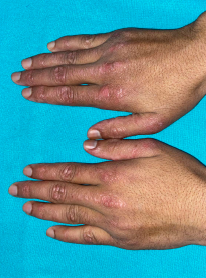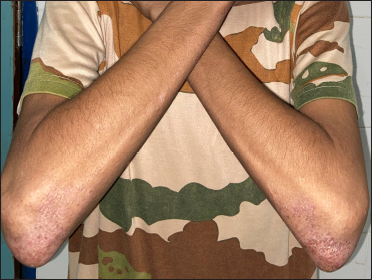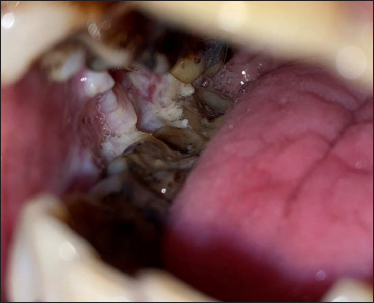Translate this page into:
Eponyms in dermatology linked to Gottron
Corresponding author: Dr. Shreya K, Department of Dermatology, STD & Leprosy, AIIMS Bhopal, Madhya Pradesh, India. shreyakgowda@gmail.com
-
Received: ,
Accepted: ,
How to cite this article: Shreya K, Gupta P, Asati DP, Verma P. Eponyms in dermatology linked to Gottron. Indian J Dermatol Venereol Leprol 2023;89:620–1.
Heinrich Adolf Gottron (1890-1974) was a renowned German dermatologist known for the description of various dermatological conditions, the most famous of which is the pathognomonic sign of dermatomyositis known as Gottron’s papule and Gottron syndrome. This article is a tribute to the great dermatologist and his contribution to the field of dermatology.1
Gottron papule: Gottron papules are inflammatory, flat-topped to concave, lilac-coloured, non-tender papules to plaques distributed on the skin overlying the distal and proximal interphalangeal joints and metacarpophalangeal joints on the dorsum of the fingers [Figure 1]. Sometimes they can involve the extensor surface of elbows and knees [Figure 2]. It is better appreciated in fair-skinned individuals and is a pathognomic sign of dermatomyositis.2
Inverse Gottron papule: Gottron papule can rarely present over the palmar creases of the finger, where it is known as an inverse Gottron papule. It is seen in dermatomyositis.2
Gottron sign: This is characterised by a symmetric, violaceous, macular erythema involving the interphalangeal joints, olecranon process, medial malleoli and patella. It is seen in dermatomyositis.2
Sclerodermoid amyloidosum Gottron: This term was first described by Gottron in 1932 to describe sclerodermoid changes of skin in patients with primary systemic amyloidosis. Usually, primary systemic amyloidosis is characterized by confluent, white to yellowish coloured, waxy, partially hemorrhagic papules or nodules predominantly over the face, eyelids and scalp but it can also present with scleroderma-like skin changes if the dermis is extensively infiltrated by amyloid, when it is known as sclerodermoid amyloidosum Gottron.2
Gottron-like papule: It is similar in presentation to Gottron papules, without other features of dermatomyositis. It is seen in systemic lupus erythematosus.3
Gottron acrogeria (Gottron syndrome): ‘Acrogeria’ is a term used to describe premature aging of extremities. This disorder was first described by Gottron in 1941. It is an extremely rare disease characterised by cutaneous atrophy and loss of subcutaneous fat over distal extremities, usually beginning soon after birth and predominantly affecting females. Clinically, the skin is dry, thin and wrinkled, especially over distal extremities with characteristic facial features such as an owl-eyed appearance, hollow cheeks, beaked nose and thin lips, giving a senile look to the patient. The patient has no increased risk of atherosclerosis or diabetes with a normal life expectancy.4
Darrier-Gottron erythrokeratoderma (progressive symmetrical erythrokeratoderma): It is a rare variant of erythrokeratoderma, characterised by symmetrically distributed, geographical fine scaly plaques with orange-red erythema, usually appearing at infancy. It mainly affects the shoulder girdle, buttocks and cheek and are non-migratory in nature as opposed to erythrokeratoderma variabilis. It is caused by a mutation in GJB4 encoding connexin 30.3. A new locus on “chromosome 21q11.2-21q21.2” was identified in a Chinese family, but no responsible gene has been found to date.5,6
Papillomatosis cutis carcinoides of Gottron: It is also known as florid oral papillomatosis or verrucous carcinoma. Clinically, it is characterised by exuberant, warty, papillomatous lesions mostly involving the oral cavity, [Figure 3] but can sometimes involve the pharynx and larynx. It can extend into underlying structures and can rarely metastasize to lymph nodes. It has a high rate of recurrence and a tendency to undergo carcinomatous changes. The risk factors for the development of this condition include human papillomavirus (HPV) infection, tobacco use, chronic inflammation and irritation of the mucosal surface.7
Arndt-Gottron disease: It is also known as scleromyxedema or generalised papular and sclerodermoid lichen myxoedematosus. It is a rare disorder, usually affecting adults and is clinically characterised by a generalised symmetric eruption of pinpoint to pinhead sized, firm, waxy, dome-shaped papules, commonly over the dorsal aspect of hands, forearms, head and neck region, upper trunk and thighs. The arrangement of papules is in a linear fashion, with surrounding skin showing sclerodermatous changes. Histologically it is characterised by a triad of diffuse deposit of mucin in the upper and mid reticular dermis, an increase in collagen deposition and proliferating and irregularly arranged fibroblasts. It has a chronic, progressive course with involvement of various organ systems.8

- Lilac-coloured, flat-topped to concave papules over the distal interphalangeal, proximal interphalangeal and metacarpophalangeal joints on the dorsum of the fingers

- Lilac-coloured, flat-topped to concave papules over extensor surface of elbows

- Exuberant, warty and papillomatous lesion, mostly involving the oral cavity
Declaration of patient consent
Patients’ consent not required as their identities are not disclosed or compromised.
Financial support and sponsorship
Nil.
Conflict of interest
There are no conflicts of interest.
References
- Heinrich Adolf Gottron zum 75. Geburtstag [Heinrich Adolf Gottron on his 75th birthday] Asthet Med (Berl). 1965;14:85-8.
- [PubMed] [Google Scholar]
- Burns T, Breathnach SM, Cox N, Griffiths C, eds. Rook’s textbook of dermatology. John Wiley & Sons; 2008.
- Gottron papules mimicking dermatomyositis: An unusual manifestation of systemic lupus erythematosus. Cutis. 2018;102:E16-8.
- [PubMed] [Google Scholar]
- Acrogeria (Gottron type): A vascular disorder? Br J Dermatol. 2004;151:497-501.
- [CrossRef] [PubMed] [Google Scholar]
- Progressive symmetric erythrokeratoderma: A rare case report. Indian Journal of Paediatric Dermatology. 2016;17:309.
- [CrossRef] [Google Scholar]
- Progressive symmetric erythrokeratodermia of Darier Gottron. Dermatologica. 1990;180:196-7.
- [PubMed] [Google Scholar]
- Papillomatosis cutis carcinoides Gottron [Papillomatosis cutis carcinoides Gottron] Rad Med Fak Zagrebu. 1970;18:81-7.
- [PubMed] [Google Scholar]
- Arndt Gottron scleromyxedema: Successful response to treatment with steroid minipulse and methotrexate. Indian J Dermatol. 2009;54:193-5.
- [CrossRef] [PubMed] [Google Scholar]





